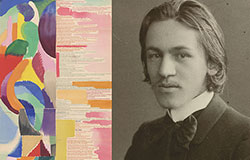
Paris : Éditions des hommes nouveaux, 1913.
Gift of Dr. Gail Levin, 2021.
Text printed in multiple typefaces inked in various colors, illuminated with pochoir in gouache and watercolor, with some brush play and overlap of wash in stencil areas.
"Tirage de luxe, No ... . De 1 à 8 pour l'exemplaire parchemin. De 9 à 36 pour les exemplaires japon. De 37 à 150 pour les exemplaires simili japon"--Edition limitation statement.
Library's copy numbered 136, printed on simili japon and signed by Cendrars in purple ink.
1 folded sheet : color illustrations ; 1991 x 355 mm folded to 180 x 95 mm
Inscribed in brown ink by Cendrars to the painter Morgan Russell: "à Morgan Russell, en souvenir du soleil de Cannes durant l'hiver 1917 / Blaise Cendrars."
Morgan Russell (1886-1953); Suzanne Raingo Russell (1890-1980); Gail Levin.
Four sheets joined together and folded in half vertically, then accordion-folded in twenty-two sections, mounted on parchment pochoir covers painted in wash and in black, blue, green, red, purple, yellow, orange, pink, and grey oil after a composition by Sonia Delaunay.

